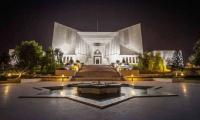ISLAMABAD: The Punjab province has thought of a ‘16-point Action Plan’ to combat smog, including fitness regimes for all public and private vehicles, replacement of 20-year-old vehicles, continuous air pollution monitoring inspection and enforcement of law against violations in 36 districts/cities. There is also a need to implement an Electric Vehicle policy whereby the replacement of EV bikes and 2-3 wheelers and buses requires billions of rupees in funding.
However, implementation on this action plan has simply remained poor due to which many cities in Punjab are facing a severe smog, especially provincial capital Lahore and other major cities.
For enforcement of law against violations in 36 districts/cities, it is proposed by the Punjab government to take action against black smoke emitting vehicles, pollution-emitting industries and brick kilns, burning of waste/tyre/plastic, crop residue/staple burning, fugitive dust emission on road, traffic congestion, illegal encroachment of roads (vehicles /stalls) and open dumping of municipal and construction waste/improper waste management and disposal. To implement all these enforcement actions, there is a need for an operational budget.
There is also a need for an MIS application (SANS Application) by all concerned departments and monitored by the Environmental Protection Agency (EPA) inspectors in each district, engagement of youth and community for reporting of violations, appointment of environment ambassadors and training to departments and youth.
For vehicle fitness regimes for all public and private vehicles, including three and two-wheelers, the proposed action is the inspection of catalytic converters installation in all types of vehicles, and replacement of vehicles older than 20 years, which has the potential to reduce emissions by 42%, from 153 to 107 Gigatons, motorcycles and scooters are 69% and cars are 23% which contribute to Lahore pollution, whereas Delhi has 67% contribution of motorcycles and scooters, and 26% from cars to air pollution.
The government had allocated Rs465 million in ADP 2022-23 for the expansion of VICS. It is proposed that the inspection fees will be paid by vehicles.
There is a need for establishment of inspection workshops in Public Private Partnership (PPP) mode, notification of testing requirements and electric bike manufacturing incentive with battery tax rebates. There are 6.29 million registered vehicles in 2021, 2.4 million in 2011, 0.81 million in 2001, and 0.24 million in 1991 in Lahore.
The Delhi government has banned diesel vehicles (more than 10 years old) and petrol vehicles (more than 15 years old), hence GNCTD has deregistered 4,877,646 vehicles till 2021-22.
For EV Policy, there is a need for conversion of existing fleet of 2-3 wheelers with EV bikes and replace 30% of 2-3 wheelers by 2025 and replace existing fleet of buses with EV buses. It requires Rs1.3 billion for 30% conversion of 2-3 wheelers, Rs4.4 billion required for 100% conversion of 2-3 wheelers.
For improved and sustainable public transport, there is a need for multimodal transport system at the metropolitan level by integrating rail-based public transport (urban rail network) with the metro and connecting buses and development of the remaining two mass transit lines (purple and blue lines) as proposed in the Lahore Master Plan for sustainable public transit and traffic management systems in Lahore. It is proposed greening of cities through urban plantation and afforestation patches in cities. A mature tree can absorb approximately 25kg of CO2 per year. There is need to incentivize solarization in the residential and commercial sector. The total emissions of Lahore are 153,000 tons (153 Giga-Grams). An integrated plan needs to be prepared for cities for carbon offsetting, including plantation and solarisation.
For mitigation of pollution in hotspots of Lahore, there should be proper implementation of Environmental Management Plans (EMP) in construction projects. These projects are responsible for fugitive dust emissions and smog, which is often visible in hotspot areas. The EMP implementation/enforcement by EPA and third parties and reporting online need to be in place.
The action plan proposed Greening of Industries, Climate Resilient Cities & establishment of air quality monitoring regime in 12 cities with latest studies on Punjab Air Quality Act, Development of Emissions Inventory, Climate Action Plan for Lahore, Air Action Plan for Cities and Biodiversity Conservation & Protection Plan for cities.
It is proposed placement of Graded Response Action Plan (GRAP), establishment of environmental monitoring system and sectorial guidelines for effective environmental governance, placement of best available pollution control technologies, fugitive dust hotspots around construction sites, waste segregation, treatment and disposal facilities, crop residual burning and continuous air quality monitoring (Ambient, At-source/Stack emissions) and inspections. The 30 air quality monitoring stations will be procured and installed by EPD.
An expert on environment commented that the approach towards climate change disaster is always reactionary rather than adopting proactive approach to ensure prevention.
When Senior Provincial Minister Punjab Marriyum Aurangzeb was contacted on Sunday, she replied that they required 8 to 10 years to combat smog on the pattern they had done in the last eight months. For the first time, they allocated Rs10 billion for planning and Rs100 billion for climate change. They allocated Rs8 billion for 5,000 super seeders and plan for Pakistan.
For the first time, sectoral approach with budgetary allocation with short, medium- and long-term plans were envisaged and implemented. Smog was never allocated money in Punjab, she added. Citing the example of Beijing, she said they started work in 1998 and with improved technology they overcame this problem.
Extending New Year greetings, Punjab CM prays for prosperous and happy year for Pakistan
IT ministry special secretary says that all online content is blocked only by shutting down internet
Project includes installation of 12,000 CCTV cameras with varying resolutions, for which 2,525 pole sites have been...
Musk offers no explanation about new username and avatar, but move triggered immediate ripple effects
1,177 people killed in 2024 included 488 civilians, 461 security forces personnel, and 225 terrorists
MWM chief says peace deal has been signed between rival tribes of Kurram after grand jirga was held in Kohat







